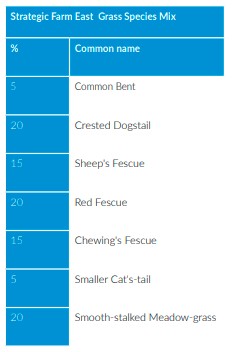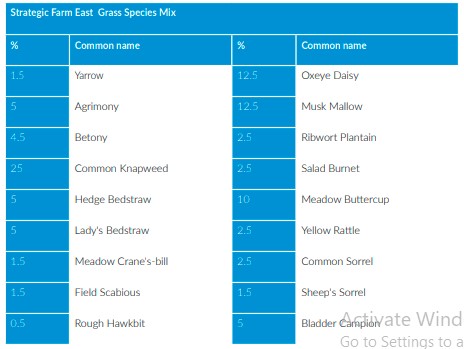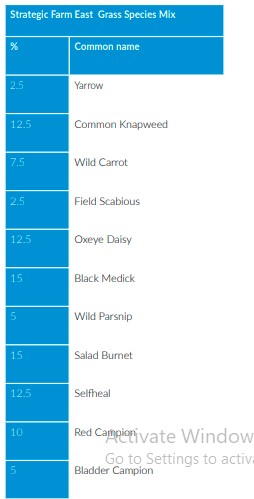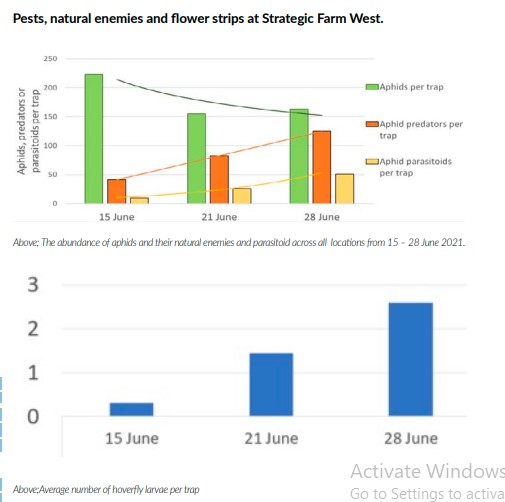Tis the time of year to reflect on progress, thing you’ change and things you’ll keep just as they are.

In this spirt, its time to review progress at AHDB’s Strategic Farms and share some results with you. From the 15 of November, we ran Strategic Farm week with four distinct themes.
• Can flower strips reduce insecticide use?
• Managed lower inputs
• Catch and cover crops
• Cultivations and soil management
We’ll take a brief look at the Wildflower and grasses mix establishment and the beneficial insects it attracts and how far they can migrate.
Can flower strips reduce insecticide use?
Patrick Barker of CJ Barker & Son, Lodge Farm, Suffolk AHDB Strategic Farm East grows wheat, barley, rye grass for seed with a strong emphasis on conservation management and healthy soils as the foundation of the farm. “We know BPS schemes are being phased out and we are already preparing for that” he said. “the farm margins must be included as the whole farm management and employed to deliver a viable farm business” Establishment, into a ryegrass stubble, Sumo Trio pulled through, then power harrowed and used a tined seeder at half rate and covered twice and rolled.
Thistles were dug out and hand, one plot established in spring 2020 and central plot established in the following autumn. What’s the biggest lesson? Ensure the conditions are right, fine seedbed with warmth, moisture with rain in the forecast. Overall, however, ‘farm like an environmentalist’ confirms Patrick. David Aglen, Farm Manager at Balbirnie Home Farms, has hosted Strategic Cereal Farm Scotland since September 2020, a 1,200-hectare mixed farm with 800 hectares of arable crops and 200 suckler cows and a diverse rotation including oats, spring barley, winter wheat, spring beans, potatoes and brassica vegetables
Key areas of focus include regenerative agricultural practices,



plant and soil health and reduced inputs.
His Strategic Farm has just started last year and is at a much earlier stage, in fact at the baselining stage of the project. Not in any environmental schemes as they are too difficult to incorporate into the business. We are looking to introduce more livestock into the arable side of the business. As for flowering strips, they are established on the field veg side of the fields ends and within the tramlines to help with soil erosion and to see if more beneficial insect species into the fields as well as pollinators. As, yet Scottish policy makers have not published what farmers should focus on. Aoife O’ Driscoll, Crop scientist at the NIAB Group, specialising in pathology and entomology and strategies for disease management,
Looking at establishment of species it should be remembered some will take longer to establish and will become prominent in the next few years. No encroachment is seen yet but is expected from year 2 and beyond. No two floral strips were alike in their plant species composition, think about location, establishment, and management:

Location
• Select sites that don’t have existing/near to noxious weeds problems
• Less fertile soils are better to discourage grasses
• The wider the sown area the better to avoid ingress from the edges.
• Selecting plant species appropriate for the soil type and climate
• Even better if they already occur in other areas on the farm,
• Grasses can be included but usually establish anyway
Establishment
• To cultivate, direct or plough?
• If you have a weed burden, keep cultivating pre-sowing, no real benefits seen between ploughing and cultivating but either practice must see a warm, moist seedbed.
• Weed problems: repeat the process of cultivating and letting weeds emerge as many times as possible before broadcasting on to a fine seedbed then roll.
• Sow when warm and into a moist soil March/April or August/ September
• Avoid dry periods.
Management
• Options: Cut and collect, cut and leave or cut in spring?
• Avoid cutting all areas at the same time to ensure that flowers are constantly present somewhere.
• Leaving some scruffy areas or allowing weeds to survive in the crop also has value e.g., for bees.
• Many hedgerow plants are also valuable and should be encouraged e.g. hogweed, wild parsnip
Hoverfly larvae are great little predators, eating 100s of aphids before pupating and emerging as flies. The flies don’t eat aphids but need to find pollen and nectar – so floral strips are really important for them around arable crops.
Key take home messages; Pests & natural enemies
• Predators disperse into the field at different rates and can complement each other
• Grassy beetle banks can provide infield overwintering habitats
• In field flower strips can provide forage for parasitic wasps and hoverflies when adults
• Multifunctional margins: Flower strips + tussocky grass species, or alternate grass and flower strips
• Diversity of habitats support a diversity of natural enemies & pollinators
As Strategic Farm Scotland further established into the project more data and answers will emerge. Clear there is plenty more work and analysis to complete. Stay tuned within these pages and look-up AHDB Strategic Farm on-line for much more information.